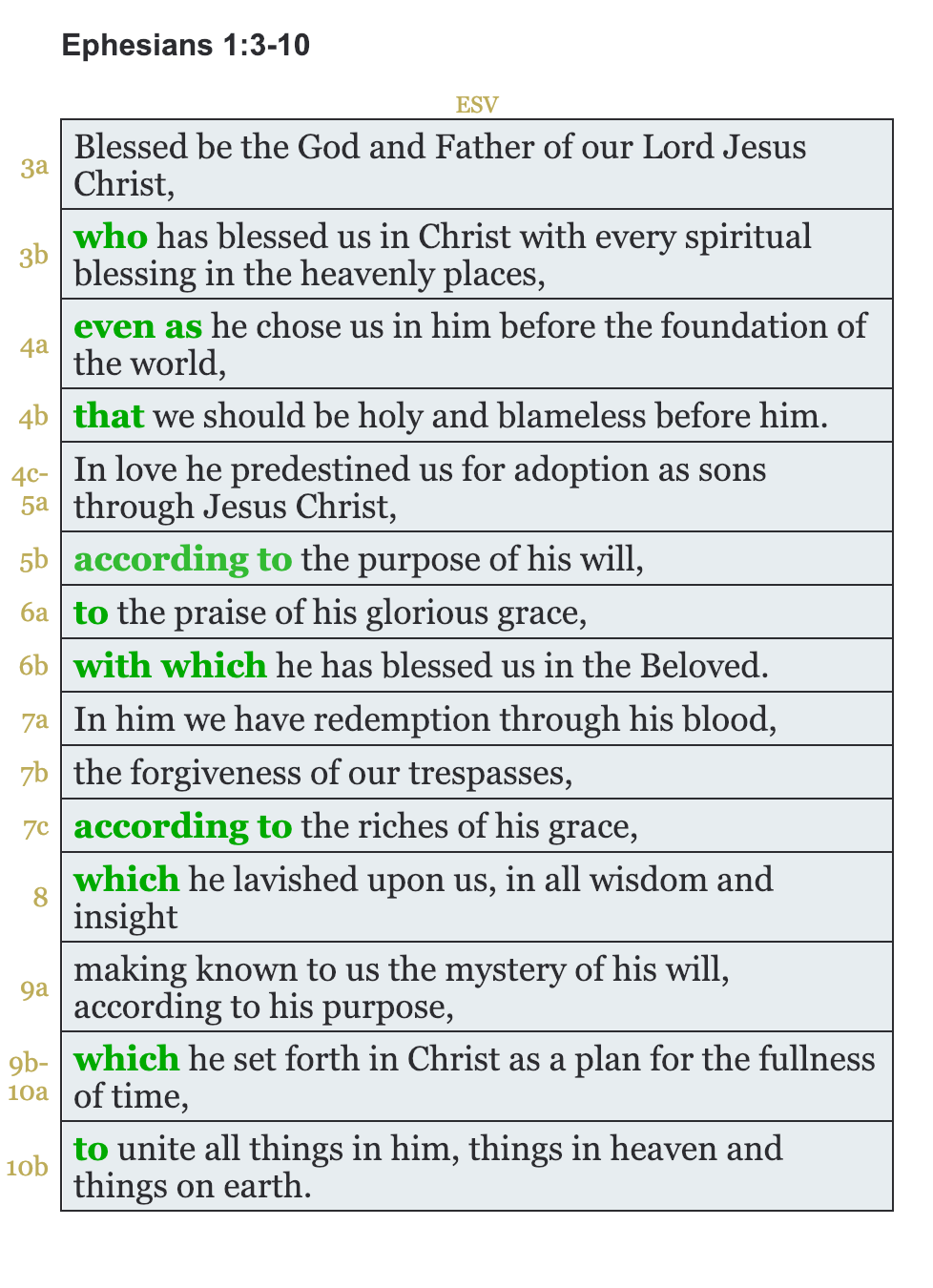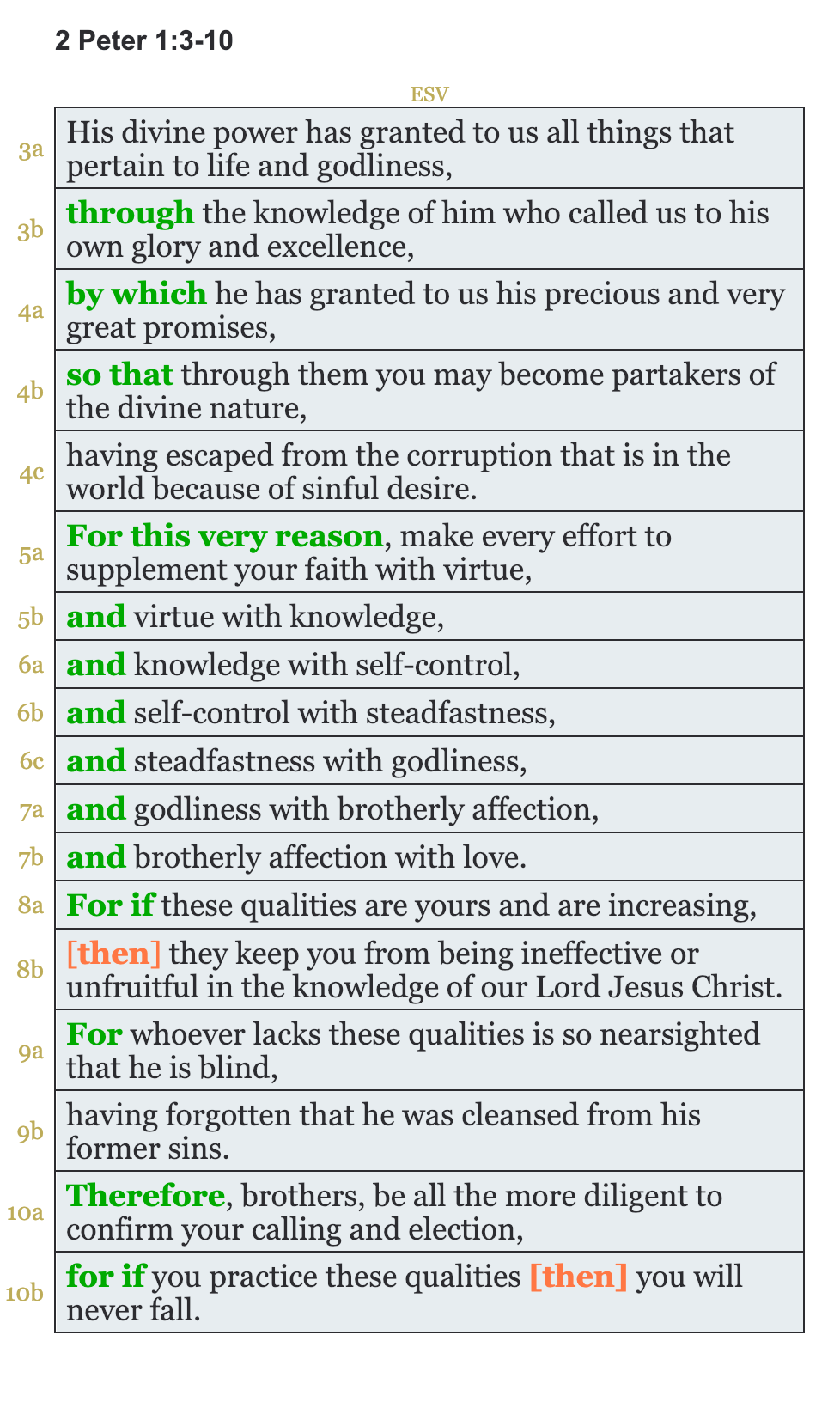Lesson 4 | Links in a chain: connecting the parts
Links in a chain: words that connect ideas
If we want to fully understand what an author is communicating, we need to go beyond simply identifying what he is writing about. We need to grasp the flow of his thoughts. It is therefore essential to discern the connections between the units of thought. These connections are very often made by common, simple, easily overlooked words—words that form vital links in the chain. The following blog post by Dan Brendsel helpfully articulates the truth that it is the little words that can make the biggest impact.
It is of utmost importance to realize that Scripture argues. It doesn’t just give pearls on a string that we can take away individually and reflect upon. It reasons with us, argues a point, tries to persuade us of particular realities and toward certain ways of living. And it is of great benefit for us to grasp those arguments, see how they work, trace them from beginning to end, and discover the deep power in them for life-change. ...Scripture is not just a collection of energy packets; it’s a five-course meal. It’s not just a bunch of pearls on a string; it’s a chain strong enough to pull you out of any trial. ...One of the first things to consider is also one of the most inconspicuous and unobtrusive — namely, the little words of Scripture. It is the conjunctions (like “and” and “but”), the prepositions (like “in” and “on”), and the adverbs (like “well” and “fully”) that tip us off to an author’s train of thought, to how one clause relates to another, to how one paragraph builds on that which precedes and prepares for that which follows. Paying attention to these little words opens up for us big worlds of thought and theology and practice and living. ...There is big significance in the little words of Scripture. They are God’s gift to help all of us “eat this book” for our health and life. You need not be a world-class theologian, and know all the big words and technical terms, to read your Bible and understand it. In fact, it’s actually the simplest little words — the ones we’re all familiar with — that most often change everything.
I encourage you to take the time to read the whole article where Brendel uses Philippians 2:14-15 to illustrate his point.
So whatever you wish that others would do to you, do also to them…
Jesus
Or take this very familiar verse, the Golden Rule, from Matthew 7:12. Have you ever considered that this verse begins with the word “So…”? Pastor and writer Steve Fuller helpfully unpacks the value of this little word.
Here Jesus calls us to do as much good for others as we want others to do for us. But if we are honest we will ask “What about us? Who’s going to do good for us?” Jesus loves that question. And He Himself answers that question, in— The most important word in the Golden Rule It’s the word “so,” which means “therefore.” Look at the verse again— So whatever you wish that others would do to you, do also to them. The word “so” shows that obeying this command depends on understanding the previous verse—verse 11— If you then, who are evil, know how to give good gifts to your children, how much more will your Father who is in heaven give good things to those who ask him! Here Jesus promises that whenever we ask, our Father in heaven will always do good for us (especially the greatest good of giving us more of Himself). We first must understand that God will always do good for us (v.11)—so therefore we can devote ourselves to doing good for others (v.12). How to obey the Golden Rule Jesus does not want us to obey the Golden Rule by gritting our teeth and ignoring our own needs so we can care for the needs of others. He wants us to obey by first trusting all our needs to our Father in earnest prayer—resting in the fact that He is rejoicing to do us good with all His heart and soul. Then—trusting that God is passionately pursuing us with good—we can devote ourselves to doing good for others.
So then, having split the passage into units of thought, our task now is to identify the links that connect them. There are so many words commonly used to connect thoughts and ideas, it will be helpful to classify them by the types of connections made.
Note: Bible study tools such as Arcing, Bracketing, and Phrasing aim to precisely define the logical/grammatical links between units of thought. In this course, though we do aim for accuracy, we will not pursue the level of precision required by these other tools.
For our purposes, it will be sufficient to define two basic categories of connections. The first category is Parallel connections. Here, you may have two or more equal parts, each making a contribution to the whole: “This and this and this…” Or, there may be either-or options: “This or that.” Finally, the parts may add one to another, developing toward an end: “This and furthermore that, and still further…”
In the second category of connections, one statement offers Support for another statement. This support can come in a variety of means as seen in the examples below. The list is not exhaustive, but is meant to help you discern the kinds of connections you will encounter.
Categories of connections
Parallel (aka “Coordinate”)
Function
Conjunctions
Equal parts
and, also
Either-or options
or
From one idea to another idea
and, furthermore
Loading...
Support (aka “Subordinate”)
Function
Conjunctions
Explanations
that is, in that, by, who, which
Contrasts
not… but…
Comparisons
like, as
Questions & answers
(look for the question mark)
Reasons
because, since, therefore
Purposes
so that, in order that
Cause and effect
so that, such that
Conditions
if…, then…
Circumstances
when, where
Objections
yet, even though
Loading...
Accurately discerning the links that connect ideas can be some of the most fruitful work in Bible study.
So let’s go back to Ephesians 1 and 2 Peter 1 in order to highlight the connector words and see these links at work.

All of these connectors link their respective statements to a preceding word, phrase, or statement by way of showing Support.
Special points to notice:
- Connectors often go beyond linking just two single statements. For example, the words “even as” in 4a connect the idea of “every spiritual blessing” in 3b to ALL the statements which follow as the specific details of the blessings that Father has given us in Christ.
- A link may join statements that are not adjacent to one another. Both 5b and 6a connect back to 4c: “He predestined us... according to the purpose of his will;” and “He predestined us... to the praise of his glorious grace.”
- There are a few statements that do not have clear connector words (4c, 7a, 7b, 9a). We will cover these in detail in the next step of this lesson.

In this passage we have a both Supporting and Parallel statements.
Special points to notice:
- A connection can be made between two larger sections. For example, at 5a, “For this very reason” connects ALL the wonderful blessings that precede as one foundation for the ENTIRE exhortation to grow in maturity that follows.
- 5b-7b is a great example of Parallel statements. Each part, connected by the word “and,’ contributes equally to the whole picture of godly character.
- Two connections can be made at the same time. For example, 8a begins, “For if...” Each word establishes a different connection. “For…”identifies a foundation for the preceding exhortation to show godly character. Meanwhile, “if…” creates a new condition for these qualities to bear fruit in one’s life, namely, they need to be yours and growing.
- I inserted the word “then” in two locations, completing the if-then connection for the sake of clarity. This is another example of an implied connection that we will look at in more detail in the next step.

